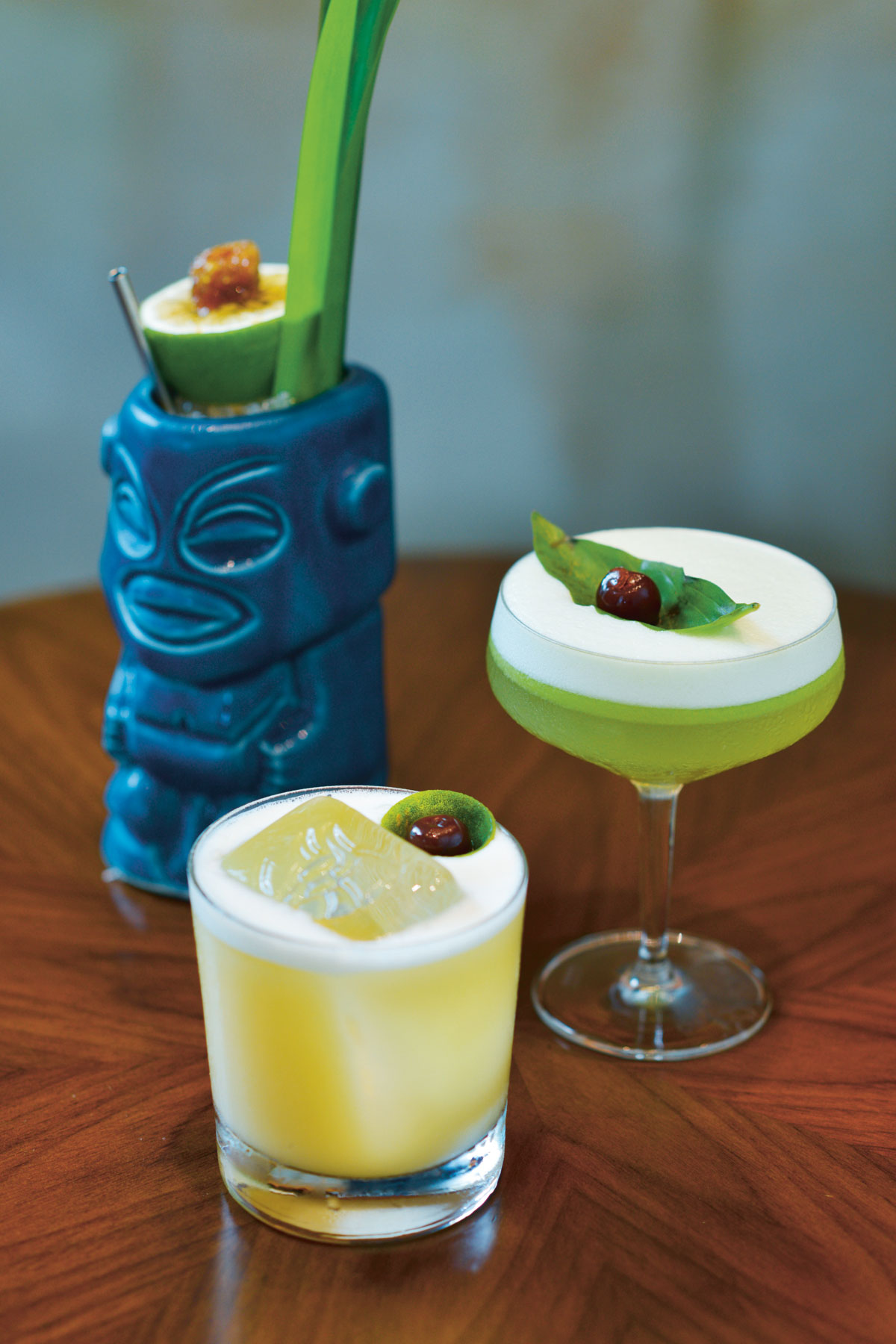Bartenders and mixologists are fast becoming celebrities. Much like chefs, they have become superstars in the food and beverage industry, impressing people with their crafty cocktails and innovations in their libations. But beyond serving delicious drinks, they are gaining ground—and ardent fans—with the way they interact with their guests, juggle their way behind the counter, and provide them with smooth moves and sweet talk.
Over cocktails, three names in the local beverage industry share how curating a convivial atmosphere matters as much to them as creating the next new drink.
Before anything, let’s get something straight. How are mixologists different from bartenders?
UJ: The term mixologist is about marketing. It’s someone who mixes different ingredients together. For example, when I came here to Manila, my card said head mixologist because people say, “Oh, a mixologist” and it’s really attractive. So to me it’s really marketing.
KB: I agree. It’s more of a status symbol, something for people to aspire to, like being on top of the chain. You know at the end of the day, being a bartender and a mixologist means the same thing: You’re there to tend the bar. You’re catering to clients. It doesn’t matter how good you are at making drinks. In reality, what’s important is how good you are at taking care of your clients.
How much of that is still part of what you do now that you have reached a certain status, run your own bars, and do consulting jobs?
KB: Now it’s more a balance between our responsibilities in our positions but that’s still part of our daily routine. Every day I step into the bar, I look after my clients, bartend occasionally, and still create the experience. There are some people who specifically request me, they say, “I want a drink made by you, can you make me something that’s not on the menu? I want to try something new.” It’s about being available and being able to do it in front of people. It’s always been a part of the routine. I’ve been encountering a lot of people, even when I’m not on shift, who say, “Hey Ken, you’re here! Perhaps you can make something off the menu for me.”
UJ: What makes you a good bartender is not mixing the best drinks, it’s creating the experience, the moment that people would remember. When they enter your bar, you don’t go, “Okay, this is the best drink.” It’s about the experience from beginning to end. That’s what being a bartender is about.
LW: Among the bar circles, the term mixologist actually has negative connotations now. It kind of invokes this image of dorky guys in lab coats and waxed moustaches who are so obsessive about the drink.
Like it has to be perfect every time.
LW: They can make you this amazing, perfect drink, but they can’t carry a conversation. All they can talk about is the drink, when they can’t tell a guest a joke, a guest’s name, or their drink preference. So in modern bar circles, that is the negative connotation. That’s why a lot of mixologists now prefer to be called bartenders. I think there should be a shift back towards service, not just for creating a great drink, but creating a great overall experience, which I think is something that is kind of lost with some mixologists today.
So the hospitality part of it is really a big come on?
LW: There’s a quote that goes, “No great story started with someone eating a salad.”
KB: Part of the reason ABV is ABV is because we established something you cannot find in other bars. It’s more about building a relationship between our clients and our staff. Opening up that bar was really tough for me.
LW: It wasn’t that bad, was it?
KB: Not on your side. It was really tough, but I learned a lot of things that made me who I am right now. And of course I also have to thank the organizers of World Class competition, Diageo, for making World Class a big event here in the Philippines because they’re exposing the market. I think my success at that competition is a factor for Filipino bartenders to push more. As proud as we are of that, it’s one thing to join a competition and it’s another to focus on the daily grind of running your bar. That’s what we try to focus on because that’s the real competition.


LW: There is something about being behind that bar where there’s a culture of speed and efficiency. You keep all your guests happy, make eye contact, you smile, get back to them in two minutes, and do your job.
UJ: A bar is different from a restaurant. In a restaurant, people come to eat, socialize, meet people, and talk to their friends so you have to make the experience better. In a bar, it’s very friendly, there is no barrier between the bartender and the people in front of you. That’s the difference and that’s what I like.
Culturally, Filipinos are not really known to enjoy small talk though, right?
LW: Traditionally, I would say you are correct. That’s why when people ask me for advice regarding a bar setup, I ask them, “Who’s your target market? Are you focusing on locals or more expats?”
You see, a lot of restaurants have a bar set up but no one really sits there. It becomes a glorified service bar and why? Because they’re catering more to locals, and it’s more the expats that like that culture of coming to the bar, chatting with and becoming friends with the bartender, meeting new people. Although I do think that there are certain bars here where they cultivate that certain culture, so even the locals who don’t normally sit at the bar will sit at the bar because they like that interaction.
There’s a certain bar culture here; people rarely go to the bars by themselves, especially women. But certain bars like ours, Ken, how often do women come in by themselves?
KB: Sixty to 70 percent.
LW: Someone getting off work from the building next door will come in for a drink because they know Ken; they know the bartenders and they feel comfortable in that environment. They don’t feel like someone’s going to hit on them.
How receptive do you think the Manila scene is to new drinks and adventurous concoctions?
UJ: The market is still young. It’s still not fully developed. But Filipinos are curious, very curious. It’s growing slowly. We are still late compared to Europe and the US, but the good thing is people are curious so you can make what you want and they are happy to try. They want to learn and they want to know new things.
How aware are you with global trends? And how much of that is a factor in your creative process as opposed to observing what the local market likes?
LW: I feel like you have to pay attention to global trends, but you have to pay more attention to local trends.
KB: It’s also about educating people. There are several trends around Asia and the Western part of the world where people are doing crazy stuff with flavors and new techniques. But the market here is very young in terms of knowledge and acceptance on those things. It’s also our responsibility to let them know about what’s going on out there, how to drink certain drinks, what goes in the cocktails. I think we’re almost at the end of the era of cosmos and margaritas.
LW: I think it’s already done.
KB: People are ready to take on the old fashioned, classic whiskey sours, gimlet. If it’s new to them, it’s a matter of educating them how to enjoy it.
“Who cares if a girl just orders a boring Lemon Drop? What do you do? You make her the best damn Lemon Drop she’s ever had, and serve it with a smile and a joke, and then she trusts you. And the next drink, she’ll order whatever you suggest to her,” says Lee Watson.
What draws people to the speakeasy?
LW: It makes perfect sense for this culture because people like the feeling of exclusivity. You go to the bar and you kind of feel in-the-know. This culture really likes that. In Manila, the term speakeasy is used loosely because historically it was about the prohibition and being underground. But modern speakeasies, for me, are bars that have serious craft cocktails, a good selection of spirits, and very well-trained bartenders. To me, among the many speakeasies in town, there’s only a handful that I would call true speakeasies. Other ones are just hidden bars.
Foraging is also a big trend right now. How actively do you source local ingredients?
KB: That’s one of the things that Bitters (Bar) is focusing on, using local produce, some not found in Manila but in the provinces.
LW: The challenge with local ingredients is the supply chain. I feel like it comes down to individual bartenders. If you have someone on your team that’s really enthusiastic about using local ingredients, then it kind of materializes on the menu.
How do you feel about cocktails on tap?
KB: It’s more of an efficiency thing, like I’ve seen a lot of trends like slush cocktails, slush rosés. It’s gonna be something new but it’s a new way of approaching the market .
LW: I think you got to be careful with cocktails on tap. I think it works for high volume concepts, but you have to have a concept where you’re really pumping out the drinks or you have drinks going out the bar every 30 seconds. To me, I get very mechanical about it and think of timing in service, say if you have 60 seats and each cocktail takes about two minutes to produce then that’s when cocktails on tap kind of makes sense because you just pour it, shake it, boom it’s done. But you need the volume for it to make sense because that keg might only last a few days before freshness of ingredients becomes an issue.
Given the choice between people remembering you for your drinks or the service, which would you like to leave a bigger impression?
UJ: The whole experience, the service, the interaction.
LW: Cocktails can be fixed easily; service is a much more complicated beast.
KB: It’s more important to please the guest. It’s easy to fix a drink, but it’s harder to fix if there’s any problems with the guest.
LW: Again, there has been a culture that’s been too focused on the drinks. I have this spiel with my staff where I say, “Who cares if a girl just orders a boring lemon drop? What do you do? You make her the best damn lemon drop she’s ever had, and serve it with a smile and a joke, and then she trusts you. And the next drink, she’ll order whatever you suggest to her.”
Originally published in F&B Report Vol. 13 No. 5











